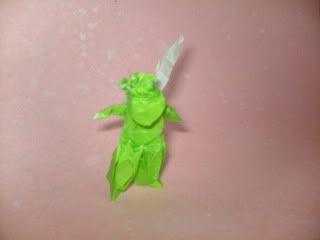I recently had to do a very large project on kingdom Arthropoda, which came out as 7 pages and 2 more pages for the reference list. Insects alone took up two pages! However, during the project, I realized what I want to fold: a horseshoe crab, of course. Horseshoe crabs are interesting animals, not being crabs at all. In fact, they are closer related to arachnids then to crustaceans. They have ten legs and their mouth in in between all their legs. I decided that I want to fold the full thing, complete with the legs, mouth, and gills. However, I had to start simple otherwise I wouldn't even have the shape. So I started with a kite base and made only the cephalothorax, abdomen and telson (tail). Here is the CP that I used:

It is a fairly simple CP, and doesn't require that much shaping afterwards. The cephalothorax needs to be shaped, and the abdomen needs spikes. The telso is better if thin, too. As mentioned above, I'm going to try and make a second horseshoe crab that is much more detailed. However, it might take me a while...


 The ears are on the bottom and the nose is on the top. It shouldn't be too hard to get the details, only the nose needs to be widened and closed, the ears opened up and shaped and the bottom corners of the head folded behind.
The ears are on the bottom and the nose is on the top. It shouldn't be too hard to get the details, only the nose needs to be widened and closed, the ears opened up and shaped and the bottom corners of the head folded behind.


 The ears are on the bottom and the nose is on the top. It shouldn't be too hard to get the details, only the nose needs to be widened and closed, the ears opened up and shaped and the bottom corners of the head folded behind.
The ears are on the bottom and the nose is on the top. It shouldn't be too hard to get the details, only the nose needs to be widened and closed, the ears opened up and shaped and the bottom corners of the head folded behind.
















